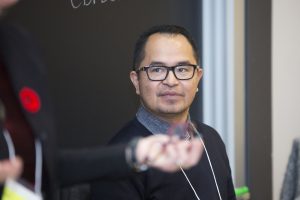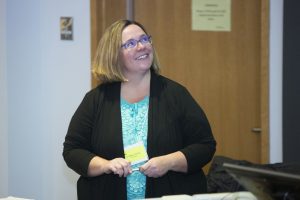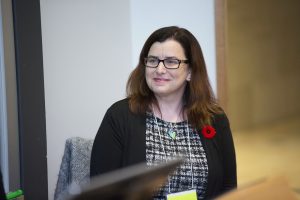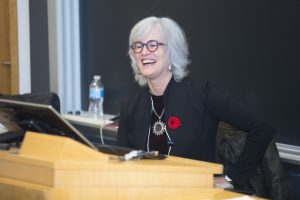Notes from our Making Connections Conference 2017
Building informed citizens through math
Speakers:Bev Caswell: Program Director, the Robertson Program for inquiry-based teaching in math and science. Robin Coyle: teacher at George Webster Public School Ariel Vente: K-12 Learning Coach, Toronto DSB Moderator: Martha MacNeil, Trustee, Upper Grand DSB
|
Overview:Imagine a group of elementary students figuring out a way to make their playground safer, proposing changes to the teacher supervision schedule, addressing the challenges raised by staff, and seeing their plan implemented. When educators build on the lived experiences of their students in order to bring the curriculum to life, and engage students in issue-based community action, students of all ages become agents of change. In this session, you will learn how students can use their budding math skills to address real-life problems – making math more relevant and developing their citizenship skills at the same time. |
 Ariel Vente |
 Robin Coyle |
 Martha MacNeil |
 Bev Caswell |
Presentations
Click the panelists names to see notes from their presentations
- Has experienced math as a “gatekeeper subject” as a student and as a teacher
- “I feel like I have a score to settle with mathematics”
- Key idea: trying to find ways to re-learn and observe math as a human endeavour
- Example Project: George Webster elementary school – site of doctoral study
- Used Participatory Action Research (PAR) model – centering participant voice in research development/design
- Focus: studying recess** using mapping, graphing – applying math to a real life situation that students can connect with
- Major concern: would grade one children understand/be able to interact with this map/spatial awareness? In fact, they were very much able to do so.
- Maps revisited in January with students, and they were asked “what questions emerge when you look at these maps?” The questions raised by the students provided them with direction for their own follow up investigations.
(Grade 4 teacher and research partner with Bev Caswell on the George Webster project)
- Had heard a presentation at Ontario Institute for Studies in Education (OISE) on Participatory Action Research
- “Aha” moment – identified that PAR is real life data management in action! Grade 4s can engage with that!
- Wanted “permission” for her new idea – needed the confidence – partnering with a PhD student allowed this.
- Started with a “carpet” conversation with students—what could we change about recess?
- They then discussed math component – why do we survey? Why do we need data? How can we be convincing if we want to make our point clearly?
- Great part: the conclusion – looking back and reflecting on data that was gathered. Asked students to answer questions like “what did you find out? What are you going to do with your data?”
- Involved his students in the Regent Park Memorial project
- Regent Park – built in the 50s/60s, one of the largest community housing projects in Canada
- Extremely diverse, vibrant community
- Over the past several years, Regent Park has been going through a process of revitalization/gentrification. In this process, people were being displaced
- Project started by listening to what kids were saying about this transition:
- sense of loss
- “it doesn’t feel like I have a community”
- “I don’t know what’s happening”
- kids unsure if they were moving out of the school/class
- sense of a disappearing history
- Vente took this as inspiration
- wanted to take the project into the community in a tangible way
- wanted to give students a feeling that they could do something
- worked with the group Facing History and Ourselves
- Step 1: walking trip to learn about Indigenous histories in the area
- Step 2: classroom visits re: monuments/memorials
- Step 3: creating models of memorials/monuments for their community
- This is where the math came in – spatial reasoning (had to make their models to scale). Measurement/angles – guessing and checking are required
- Idea was not to teach math in isolation but to connect math themes together in applied projects. To show students: “Math is part of everything we do”.
- Visit The Learning Exchange online for further info/videos
Panel Discussion:
Moderator question: What are your “AHA” moments around teaching math?
Robin Coyle – the project described in the presentation showed that Math can be connected to being a good citizen.
Bev Caswell – “AHA” moment was that in doing math through an equity lens, I realized I need to do more work in developing this type of math content for others (need to help teachers with the skills to be able to find the math in each project/idea).
Ariel Vente –some of the things I thought students would value weren’t actually what they were focused on. i.e. I wanted them to focus on Indigenous people, and early immigrants who came to the neighbourhood. What they valued were the current neighbours/characters in their lives. I had to let go of my bias and listen to/honour what they felt was important.
Moderator question: What has the response been (to your projects)? How are you seeing change resulting from these projects?
Bev Caswell – parents were so impressed by it. Teachers were empowered by it, but it didn’t happen again/ inspire great change in that year – practical life of being a teacher gets in the way of this work.
Robin Coyle –the project bridged some division between older and younger students. George Webster became the first school in TDSB to get involved with Right to Play as a result of this project.
- Right to Play was a partner organization already
- Came in to train students to be playground leaders and leaders organize a play space in the playground
- This was a need identified as a finding of some of the games.
Ariel Vente – Parents were into the “real world” approach of the project
Moderator Question: what suggestions do you have for schools who want to take this type of programming on?
Robin Coyle – time is always the barrier. The key is to do it when it fits naturally.
Bev Caswell – take it on as a school-wide project – then you get more resources in play. It’s also fine to do it just once a year/ in a limited way. A more collaborative approach, even involving in community in design, might work better in future.
Ariel Vente – need a lot of patience, a thorough content knowledge is important. Need to value the PROCESS above the results.
Concept emerging from discussion: “real math” vs. exploratory math (i.e. projects described above )– why do we get this division in our minds? When do we develop this distinction?
Bev Caswell – important question is what meaning does the activity have to kids’ lives? (It’s not about WHAT they’re doing, but WHY they are doing it).
Comment from Lisa Lunney-Borden: One of the biggest barriers to doing this work is that a lot of people don’t know what this work looks like. Use examples i.e. ones being shown in this session.
“Drill and Practice” team is louder than our side in the media. This type of exploratory work needs more attention in media.
Consensus: Key is to start small with little projects that develop into bigger ones.
